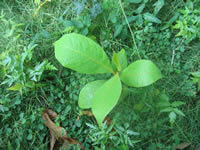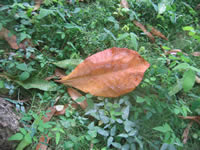What is Indian almond?
Indian almond is a large tropical tree in the Leadwood tree family. It is considered native to tropical Asia and northern Australia, but is today also common in tropical parts of the Americas. The tree has been widely spread by humans due to its desirable properties, and the exact origin of the species is therefore uncertain.
The Indian almond is not closely related to the true almond Prunus dulcis, but Indian almond seeds tastes similar to almonds when fully ripe, hence the name.
Scientific classification of Indian almond
Kingdom: Plantae
Division: Magnoliophyta
Class: Magnoliopsida
Order: Myrtales
Family: Combretaceae
Genus: Terminalia
Species: Terminalia catappa

Indian almond seedling
The tree with many names
Due to its origin in tropical Asia, this species is known in English under names such as Indian almond, Bengal almond, Singapore almond, Malabar almond, Talisay almond, and of course Tropical almond. The names Sea almond, Wild Almond and Umbrella tree are also used. Throughout its native and introduced ranges in the tropics, it is known under a wide range of national or local names, e.g. Ketapang, Ebelebo and Zanmande.
The acronym IAL stands for Indian Almond Leaf and is commonly used among aquarists.
The tree
Indian almond trees can reach a height of 35 meters (110 ft). It grows upright and forms a symmetrical crown with horizontal branches distinctively arranged in tiers. As the tree ages, the crown will become increasingly flattened and eventually take on a vase shape.
- Thanks to its growth style and large leaves, the Almond tree provides deep shade and has become a beloved ornamental tree in tropical gardens, parks and along streets.
The leaves

Indian Almond leaf
Almond tree leaves are quite big, usually 15 to 25 centimetres long and 10 to 15 centimetres broad (6-10 inches long and 4-5.5 inches broad). They are thick and leathery with an ovoid shape and sport a glossy dark green colour.
Before shedding its leaves to survive the dry season, the Indian almond tree will retract the valuable green pigmentation, leaving the leaves pinkish-reddish or yellow-brown.
Indian almond leaves contain several different flavonoids, including kaempferol and quercetin. It is also rich in various tannins; astringent, bitter plant polyphenols that either bind and precipitate or shrink proteins.
You can read more about the chemical properties of almond leaves here. The compounds found in almond tree leaves have made them an integral part of traditional medicine within their native range, and local communities in the Americas have also adopted them into their collections of home remedies.
Aquarists who keep fish native to soft, acidic and tannin rich waters – such as the Betta fish – commonly use Indian almond leaves to mimic the natural conditions of their species in aquaria. Adding Indian almond leaves to a tank can for instance help trigger spawning since compounds released by the leaves will alter the chemistry of the water, making the aquarium more similar to the habitat from which the fish hails. You can find more info about Indian almond leaves and aquariums here.
- Tannin and a black dye can be extracted from the leaves.
- In Thailand, Siamese Fighting Fish breeders have traditionally used the leaves to create more natural conditions for their captive fish.
- In India and Pakistan, juice of the leaves is used as a folk remedy against various ailments that damages the skin, such as scabies and leprosy, while the leaves themselves are used to dress rheumatic joints.
- In traditional Samoan medicine, the leaves are believed to be effective in treating wounds, eye problems and rheumatism.
- In the Philippines, the leaves are ingested by people suffering from intestinal parasites.
- In parts of South-East Asia, the leaves are believed to be effective against dysentery.
- In Taiwan, fallen leaves are believed to cure or hamper ailments pertaining to the liver.
- In Mexico, the leaves are said to help stop bleeding when a tooth is extracted.
- In various parts of South America, young leaves are believed to help get rid of colic in babies.
The flowers
The Indian almond tree is a simultaneously monoecious species, i.e. male and female flowers are found on the same plant at the same time. Both male and female flowers are roughly 1 centimetre (0.4 in) in diameter and quite inconspicuous. The colour varies from white to pale green and there are no petals. (The petals are produced on axillary or terminal spikes.)
The fruit
The Almond tree produces drupe fruits, just like the true almond and many other famous plants, e.g. plum, apricot, mango, date, olive and coffee. A drupe is a fruit characterized by having an outer fleshy part that surrounds a shell inside which you will find a seed. In drupes, the hard shell, commonly referred to as pit, develops from the ovary wall of the flower.
Almond tree fruits are corky and highly buoyant, which makes it easy for this salt tolerant species to spread by water. Each fruit is about 5-7 cm (2-3 in) long and 3-6 cm (1.2 -2.4 in).
Inside the fruit you will find the seed which is edible when fully ripe. It tastes similar to almond, hence the name. The seed is ready to eat when the fruit turns read. Just like many other fruits and berries, the almond tree fruit is green at first, then yellow, and finally red when ripe.
- The fruit and seed are edible.
- Tannin and a black dye can be extracted from the fruit.
- Oil extracted from the dried nuts is edible and used in cooking in parts of South America.
- In traditional Indian medicine, the fruit has been used to threat leprosy and headaches, and to make dressings for rheumatic joints.
- In traditional Samoan medicine, the fruit is believed to relieve coughs.
- In parts of South-East Asia, the fruit is considered effective against dysentery.
- In Mexico, ripe Indian almond fruits are used as a folk remedy against travel nausea. There are also parts of Mexico where the fruit is believed to cure or hamper asthma.
The wood
Almond tree wood is red, solid and highly resistant to water.
- Because of its reliability and resilience to saltwater, it is used to make canoes in parts of Polynesia.
The bark
- Tannin and a black dye can be extracted from the bark.
- In traditional Samoan medicine, the bark is used to threat a variety of ailments, including upset stomach, diarrhoea, coughs, and throat and mouth problems.
- In India and Indonesia, bark is used in dressings for rheumatic joints.
- In parts of Mexico, the bark is regarded as effective against asthma.
- In Brazil, the bark is used as a folk remedy against fever and dysentery.

